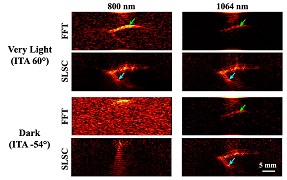Embedded fiber optics shed light on aircraft damage
Optical fiber sensors are promising tools for detecting damage to the composite structural materials used in aircraft. In particular, a type of device known as a fiber Bragg grating (FBG) sensor has proved effective at measuring the strains and temperatures experienced by these composite materials. Due to their small size and low weight, FBG sensors can easily be integrated into common composite materials such as carbon fiber-reinforced plastic (CFRP).
Together with Hitachi Cable Ltd., I have succeeded in developing a small-diameter optical fiber that can form the basis of very small optical fiber and FBG sensors (see Figure 1). The cladding of this fiber is only 40μm in diameter, increasing to 52μm on addition of a polyimide coating. This coating helps to relieve the stresses around the cladding, providing a proper combination of stiffness and thickness.
The optical fiber is easily embedded within a single CFRP sheet with a thickness of around 125μm and does not reduce the strength of the composite when situated parallel to the reinforcing fibers.1 The coating is also able to withstand high temperatures, meaning that the fiber is compatible with the high-temperature polymer matrices used in CFRP composites.
FBG sensors are very sensitive to nonuniform strain distributions along the entire length of the grating, as they interfere with the passage of light along the fiber. Accordingly, FBG devices can detect the microscopic damage that causes such strains in CFRP laminates.2,3 FBG sensors can also monitor any temperature-related stresses produced during the fabrication of CFRP laminates.4

Together with colleagues from the University of Tokyo and Kawasaki Heavy Industries, I have demonstrated real-time detection of impact damage by embedding these new optical fiber sensors in a CFRP fuselage structure with a diameter of 1.5m and a length of 3m (see Figure 2).5 The FBG sensors pinpointed the location of impacts by measuring dynamic strains, while multimode small-diameter optical fibers assessed damage based on the degree of bending. We also developed a detection and localization system that could use the signals from these sensors to determine both the location of impact and its effects.

I am now leading a Japanese national project called ACS-SIDE (Structural Integrity Diagnosis and Evaluation of Advanced Composite Structures), which was begun in 2003 as part of a five-year program funded by METI (Japanese Ministry of Economy, Trade, and Industries). The main goal of this project is to develop three structural health-monitoring technologies for advanced aircraft composite structures. These include a hybrid sensing system based on FBG sensors and piezoceramic actuators for checking CFRP box structures6 (Fuji Heavy Industries, Hitachi Cable Ltd., the University of Tokyo, Tohoku University, the National Institute of Advanced Industrial Science and Technology); highly reliable advanced grid structures (Mitsubishi Electric Co., the University of Tokyo); and strain sensing using a technique known as Brillouin optical correlation domain analysis (Mitsubishi Heavy Industries, the University of Tokyo). The aim of these technologies is to help ensure the safety and reliability of the composite structures and reduce maintenance costs.
Nobuo Takeda is head of the Division of Transdisciplinary Sciences. His current research covers experimental micromechanics of composite materials and smart sensing, and structural health monitoring of composite structures. He also leads a Japanese national R&D program on structural health monitoring.



